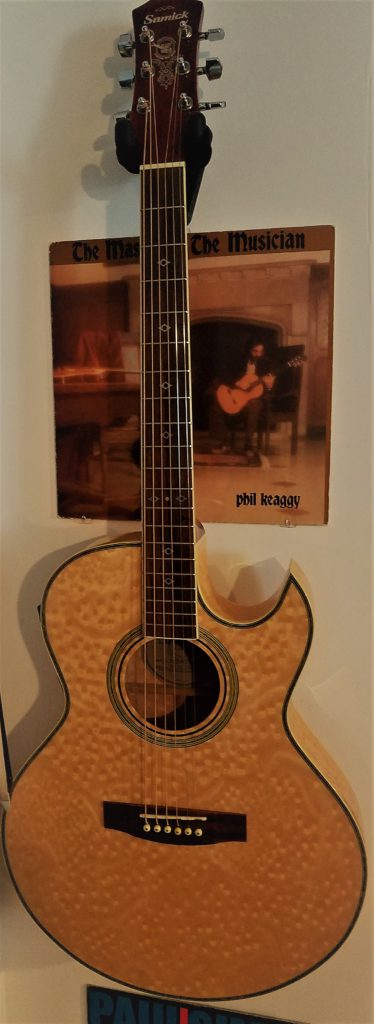
Big & Beefy!
That’s how a lot of acoustic guitar players like their tone to be.
Even me, sometimes!
But then, at other gigs, with other songs… the moment calls for something with less… girth.
The Samick acoustic guitar that I have, their “Thin Line” model AMCT-CE, is the perfect complement to such situations.
Worried you might not cut through the mix enough?? Surrender those fears! The SAMICK is here!!!
The Custom Pro Overview!
First, let’s get a quick, thorough breakdown of the specs of this unique, useful and beautiful guitar:…
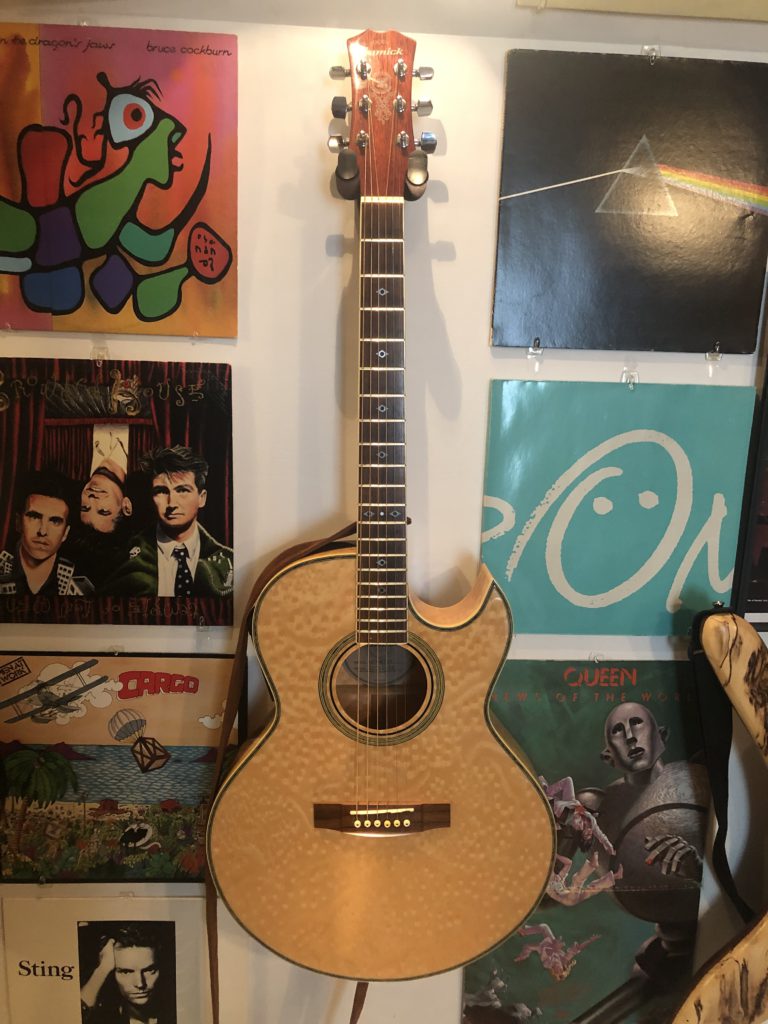
Samick AMCT-CE PBE “Valley Arts Custom Pro Shop” ThinLine Acoustic/Electric Guitar:
Top Plate: Birds Eye Maple
Binding: Back & sides
Cutaway: Florentine
Neck: Set Mahogany
Inlays: Abalone
Fretboard: Rosewood
Bridge: Rosewood
Frets: 20
Electronics: 4-band EQ plus Volume
Inputs: EQ700 XLR and 1/4″
Tuners: Chrome die-cast
Finish: Gloss
Serial #: 99050008 (8th of its line in May 1999)
Country of Origin: Korea
The Obviously Awesome… Wood!!
As is always the case with a great guitar… it’s the WOOD, baby. The WOOD!!
Take a look at this incredibly intricate, almost 3D quality of the Bird’s Eye Maple that’s used on the top resonating plate in the picture below:
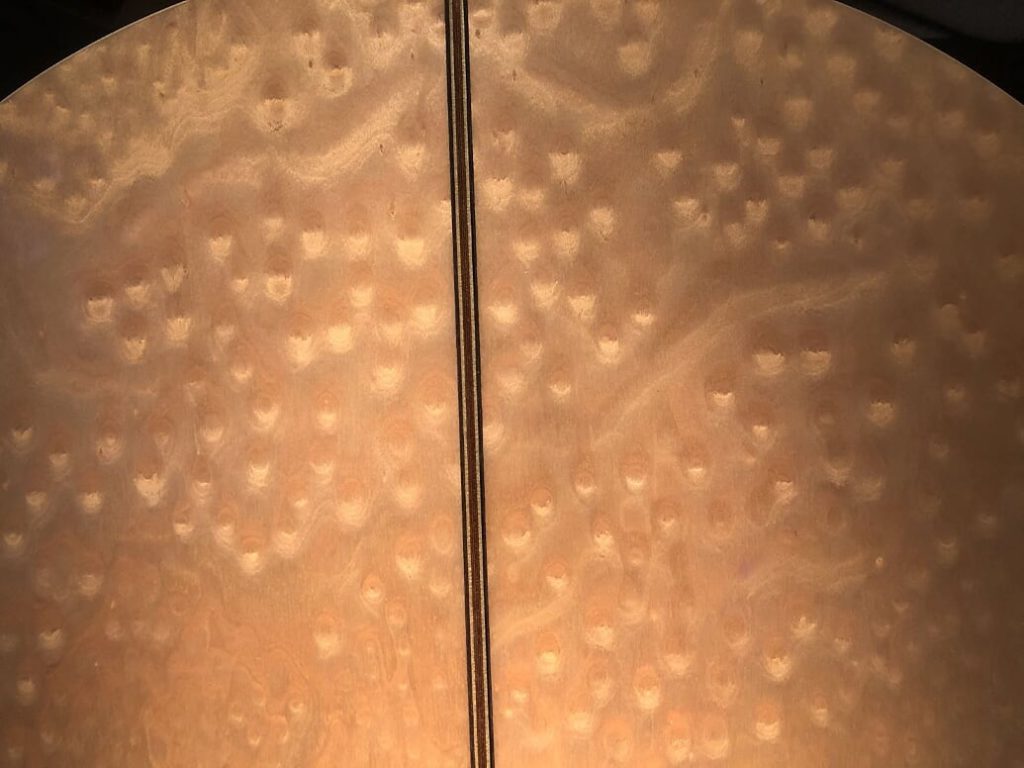
Isn’t that GORGEOUS?! It’s the first thing that caught my eye and made me consider buying it, and it’s still one of the biggest reasons I’ll never get rid of it. It’s just breathtakingly lovely.
Do you know why you don’t see many guitars with this type of wood? Because Birdseye Maple is a rare characteristic. It’s found in only about 1 percent of all maple trees!! Crazy, right?
Interestingly, nobody really knows WHY some trees get this incredible grain. There’s no scientific evidence to support any specific theory of why it happens. What makes it grow with such panache. It’s a mystery.
Which makes having a guitar made with it THAT MUCH MORE COOL!!! LOL
Anyway, as usual with unusually textured wood grain, pictures just can’t do it justice. Next time you’re in a guitar shop (may it be SOON, out of Quarantine!!), ask to see a quilted Maple or Bird’s Eye Maple or Flamed Maple top on a guitar. When you take in that miracle up close and personal, you’ll know why this li’l git-box is never leaving my Wall of Fame. ‘-)
What’s up, Slim?!
Another reason I’ll never part with this guitar (besides the simple fact that I just… well, LIKE it) is that it’s the only “Thin Line” acoustic I own.
A Thin, or Slim, line construction means (to most acoustic luthiers at least) that the BODY of the guitar is shallow. Much shallower than normal.
The depth of this Samick, for example is only 2.75 inches. The slimmest guitar I have after that, which is a standard “full-depth” acoustic, jumps up to 3.5 inches. That’s quite a difference!
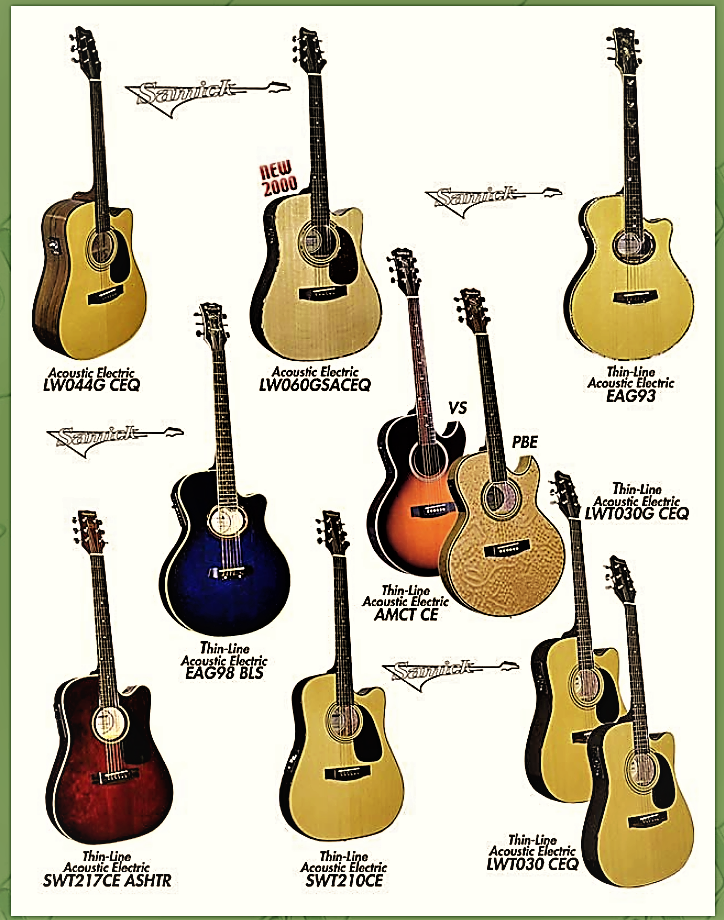
A thin line construction means (mostly) three things:
- Much less body weight & mass, so it’s closer to your body and easier to reach & play.
- A pronounced reduction in the bass frequencies, due to the smaller resonant cavity.
- Far less projected volume when heard without amplification.
Because of these specific characteristics, this guitar is perfect for use in an amplified setting, especially in a full band, where the low frequencies of a deeper body just aren’t necessary. In fact, the lows and low-mids will get in the way and are usually EQ’d out by the sound person anyway!
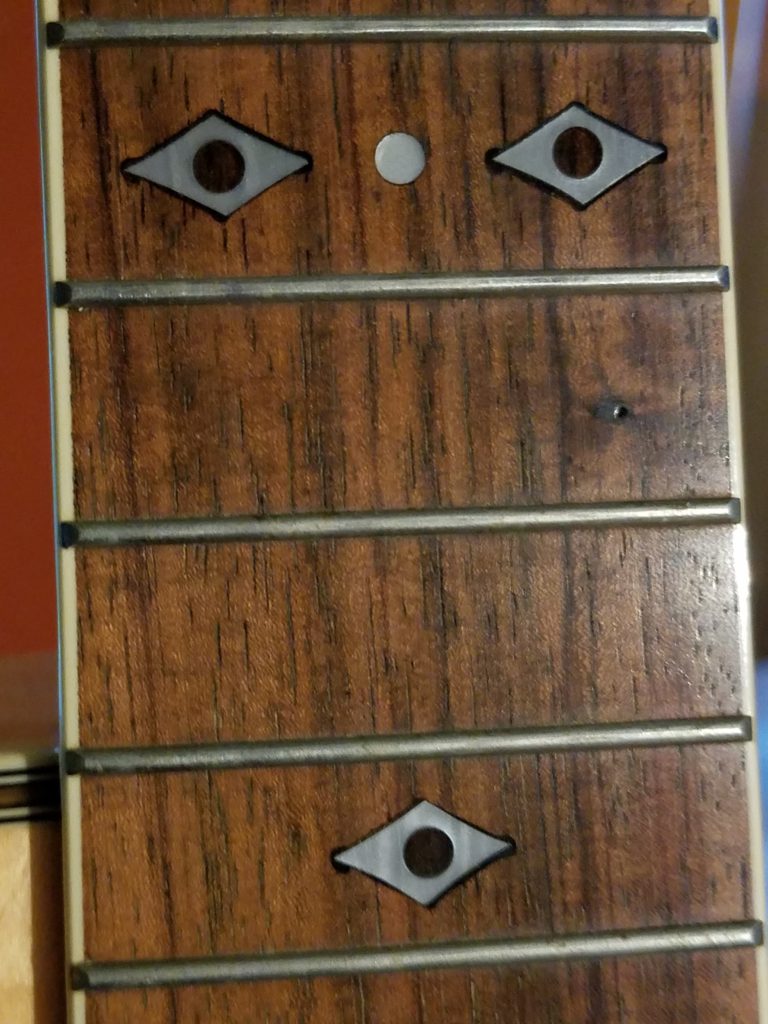
I’m sure if Samick COULD have, they would have called this a “SlimLine” guitar, since the term goes waaaaay back in guitar luthier techniques. But it’s trademarked so they can’t.
Gibson started it with their semi-acoustics (the Byrdland, ES-225, ES-335/345/355, etc.) in the 1950s.
Then Fender really took the term and ran with it in the 70s on their Telecasters. Today, when someone hears “Slim Line”, a semi-hollow bodied Tele is probably what’s going to spring to mind, due to Fenders ubiquitous and decades-long Tele marketing.
There’s another impactful dimension to the AMCT body: the depth is exactly the same at every point on the guitar. This makes a difference in how consistent the sound reflections are inside the body cavity, and thus how much sound exits.
Sometimes, like on my Mike Franks acoustic (which you can SEE HERE), a guitar may start around 3.5″ near the neck and widen out to the standard 4″ at the bottom.
Changing the inner distances between the top and back plates produces more random reflection patterns, and doesn’t “trap” as many frequencies inside. This Slim Line model stays consistent throughout, so that’s one reason it’s not as loud as others.
If you’ve never tried a thin depth acoustic, give one a try. I love how CLOSE the strings are to my body, making it so easy to play. For younger or smaller guitar students, a thin line guitar also helps with arms that aren’t so long; it’s SO much easier to fret, strum and pick!
It’s from the Valley, Dude!
So, what about this “Valley Arts” moniker?? And what is “Samick”, anyway??
Is “Valley Arts” the brand name? A model? A parent company??
“Somebody, SAVE US from this lack of guitar KNOWLEDGE!!!”
Fear not. Teaj is here. LoL
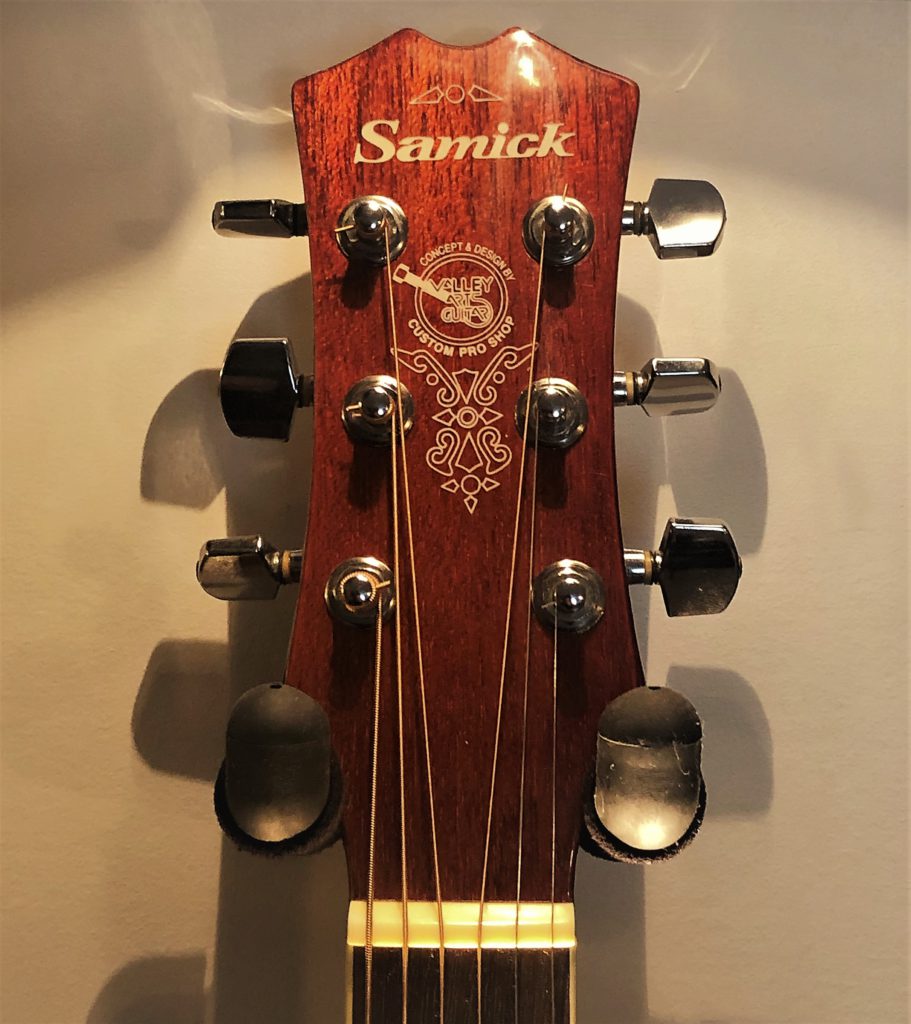
Samick has been building guitars since 1958. At one time they produced more guitars than any other plant on the planet! So, do they know a thing or two about luthiership? Yea.
They have factories is Korea, China & Indonesia. Their goods are then shipped worldwide, including to our illustrious shores.
Valley Arts Guitar was a local guitar shop in North Hollywood that I frequented when I lived in L.A. It was the bomb.
I took my first guitar lessons there, from a great player, Lindsey Blair. His teaching room was right next to Jennifer Batten‘s, another uber-talented player.
When she ended up leaving town to go tour with Michael Jackson, guess who she recommended to take her place at GIT (the “Guitar Institute of Technology”) as an Instructor there? Lindsey.
He was such MASTER at so many things. No matter what I threw at him to learn, he always could NAIL it as easily as eating the chili cheese fries they sold just down the block.
(Of course, we’d never play AND eat those at the same time. We DO care for our instruments!!)
Lindsey is still out burning up the fretboard even to this day. Check out HIS WEBSITE HERE. And HERE is the love story of a great Fender Strat he sold me!
But Valley Arts also had other very esteemed axe-slingers who hung out there all the time: Larry Carlton; Tommy Tedesco; Steve Lukather; Al DiMeola… their patrons were like a who’s who of who’s AWESOME!
So, they began to put together custom guitars for their legendary pro players. From 1977 to 1993 the line of Valley Arts Guitars were renowned and respected, especially by session players in Southern Cal.
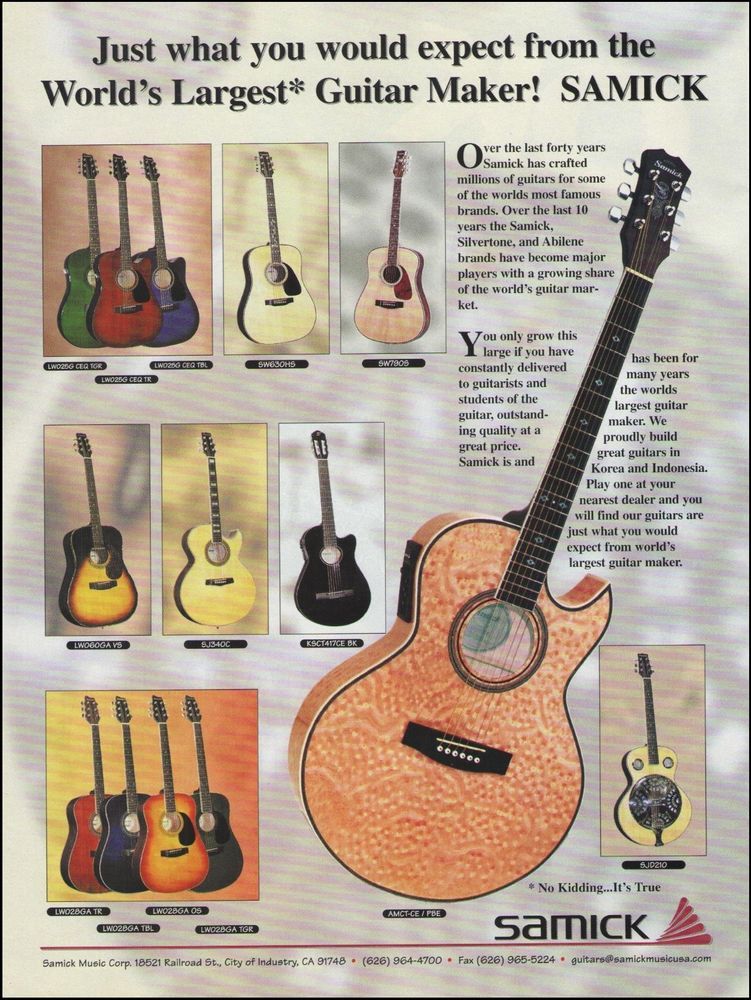
In 1993, due to an unfortunate store fire which pretty much destroyed everything, Valley Arts was sold to Korean manufacturer Samick, who at the time sold more guitars worldwide than any other company.
Samick then started to use the Valley Arts name (and thus its marketing prestige) to sell some of its higher end instruments.
When I saw this guitar for sale on Craigslist, the wood grain caught me first, but the second thing to reeeeeally draw me was the fact that it had “Valley Arts Custom Pro Shop” on the headstock.
That was my go-to store! I was there. I knew that precious musical palace! It meant a lot to me back in the day, so I had to go check it out.
Glad I did! This guitar does their heritage proud.
The JACK, Jack!
I always love it when a guitar has an XLR output.
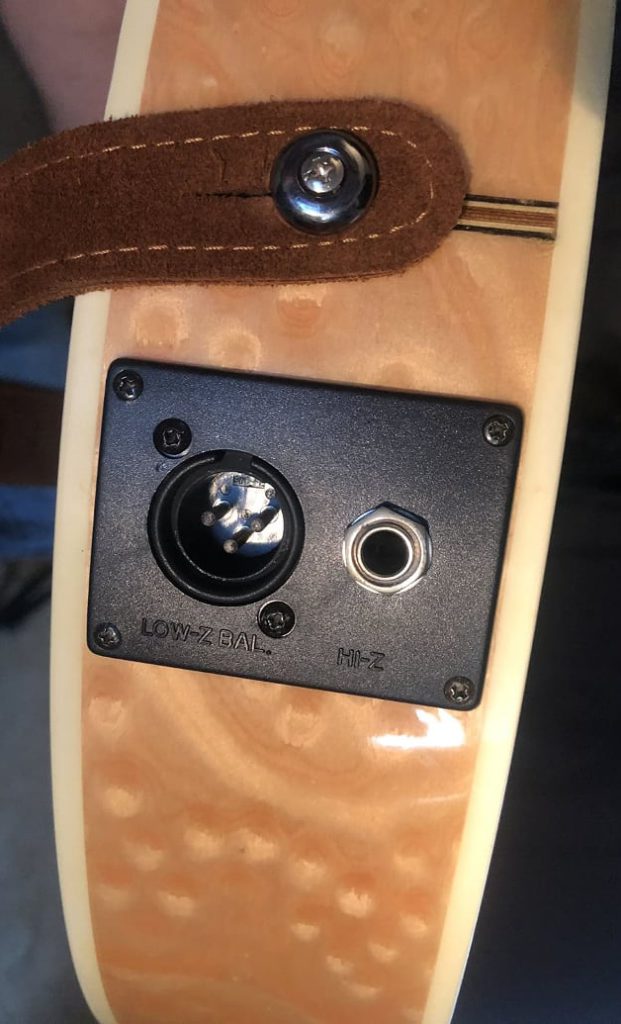
We put enough time and effort into honing our craft and our tone… we don’t need line noise & hum to creep in and ruin our musical vision.
The purity of an XLR line helps “keep it clean”, especially as you get into longer cable runs. XLR is the bomb if you want the best signal possible, and I’ll ever be a fan.
Another great thing about this set up is the STEREO options. I can run two cables out of this guitar, one XLR and one 1/4″, and place different effects on either side.
Or I can give them the same FX, but still have that massive stereo sound that is so inspiring… not only to our listeners, but to US!
Not every guitar that has an XLR out allows you to have BOTH signals, so do your homework if that’s important to you to verify that that option will be available to you.
The SOUND!
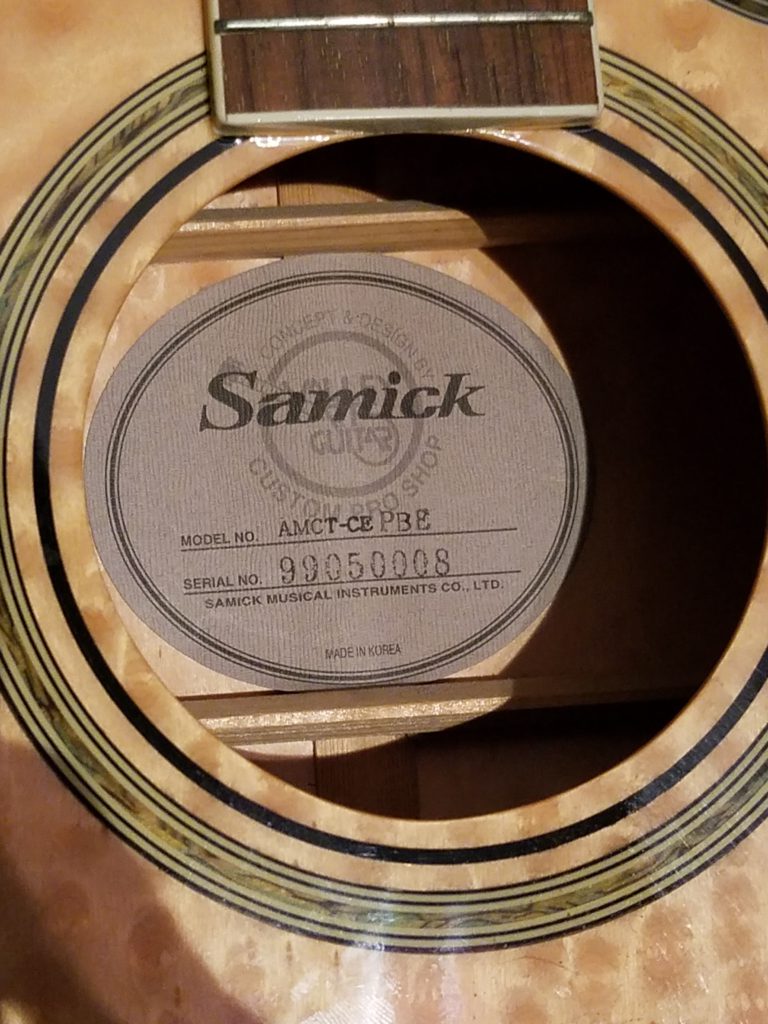
I’d describe the Samick as having a thinner tone acoustically, which is why, in the context of a band, I use it frequently.
It cuts through nicely and hardly ever needs any Hi-Pass filter slapped on it. The sound mixers love it ‘cuz they don’t have to EQ it much in the band setting.
Oh, and it has never been prone to feedback either, much to our mutual appreciation!
The AMCT has great sound & note definition as well, probably because, again, there’s no muddy, booming frequencies in the low end to get in the way of clarity.
This is great when you’re playing with a full rhythm section. You don’t want a bunch of bass frequencies, or you’ll be treadin’ on the bassist’s ground.
And he won’t like that! LOL
If there’s a weakness to this model, it’s the onboard electronics. They are not strong.
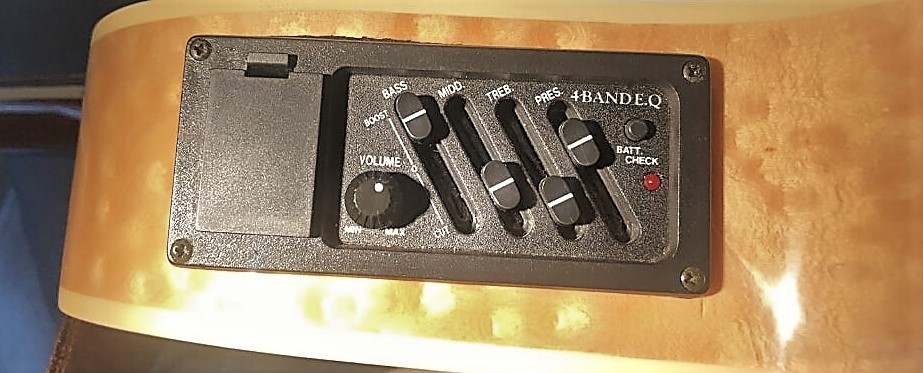
In fact, in my last concert the mixer asked me to NOT use this guitar on a louder song because the distortion was too pronounced.
If you’re playing soft, or doing fingerpicking, there’re no issues. Have at it and you’ll be fine.
But when you start playing aggressively? Ooo, that’s when distortion kicks up every time, and I mean the kind that everybody, including your audience, will notice.
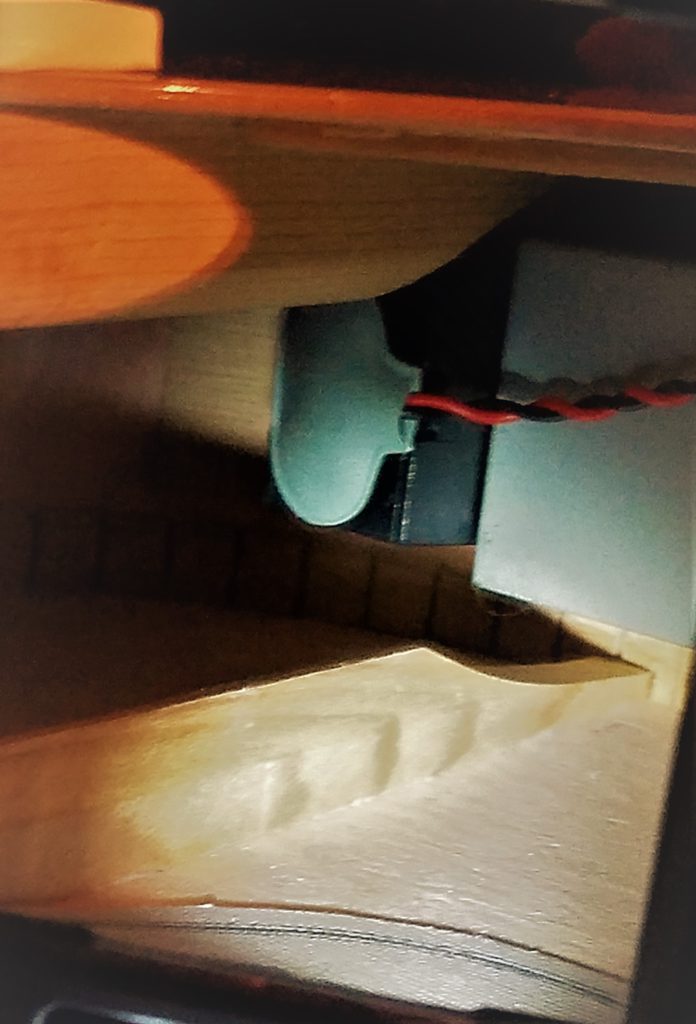
(And, yes, in case you’re wondering, the battery is always brand new when I check for this issue. It’s obviously a fault of the electronics construction.)
So, next week, I’m actually having brand new electronics put in to fix this problem. That way I can play as loud as I want (mostly on big STRUM songs) and have no issues when I use only the D.I. outputs.
I’m planning a before and after article once that’s dones, so keep your ears peeled for that post soon enough!
That being said, I absolutely LOVE how this guitar records!! The acoustic sound of the Samick is GREAT in the studio. I’ve used it many times and will continue to, as it really brings my songs to life well, whether it’s with a full band or even solo.
So, if ya don’t mind spending a Franklin or less to upgrade the electronics, this can be an all-out monster for your gigs and sessions.
I made two recordings for you that should make clear what I mean. Let’s let our ears be our guide…
The ACOUSTIC tracks at the beginning are laid out in the stereo spectrum as follows:
- Hard Left: Oktava 319
- Mid left: Avantone CK-1, at bridge
- Mid Right: Avantone CK-1, at 12th fret
- Hard Right: Oktava 319
The D.I. tracks afterward are laid out this way:
- 33% Left: 1/4″ output
- 33% Right: XLR output
I played songs into the mics that most of you (if not ALL) probably know, just for a point of reference.
- Bookends
- Dust In The Wind
- Stairway to Heaven
- Little Guitars
The D.I. cable I took straight into my Apollo interface, with NO further processing.
On the Master Bus I put an EQ’d Lexicon 450 reverb. That’s it. The sound you hear is the guitar, not software smoke & mirrors.
Keep in mind the strings are 7 months old now. This axe, like all the rest, would sound even better with new ones put on. I’m recording with it next week so you’ll get to hear it with new strings in the NEXT installment.
Hope you enjoy this as much as I do playing her!
Wait for… the DROP!
Completely by accident one year, I stumbled upon a great way to use a Thin Line acoustic guitar. The story goes like this…
I decided, after reviewing songs for potential slots on my next album, to resurrect a song that I’d written when I was 21 years old, way back in my L.A. days.
The trouble was, my voice is MUCH different than it was then, and I found that I didn’t like how I sounded in the key I wrote it in. Dropping it a whole step sounded, with my voice NOW, more soulful and smoky.
BUT… I didn’t want to have to relearn a whole new set of chords ‘cuz I was in a hurry and the finger-picking was pretty complicated.
My solution? I dropped the strings down a whole step and played the song as written.
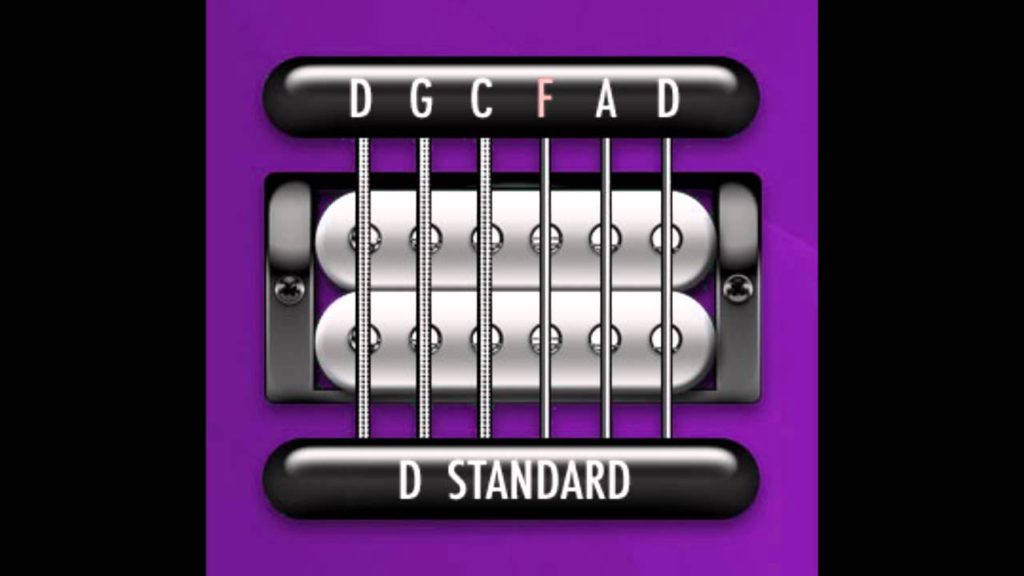
To my great joy, not only did my voice sound better this way, but the Samick put out substantially more bass frequencies now that the low string was down to D.
This lower tuning gave it a much more balanced overall acoustic sound, tho’ the volume was still not loud acoustically.
So there ya go – that’s what you’re hearing on the recording above.
And that’s what I call… a Win/Win!!
Rare Bird, Indeed
Googling my discontinued Samick model today, I couldn’t find a single used one on sale anywhere. Not on eBay, not through Guitar Center, not in Craigslist national… it’s like I have the only one!!
I even checked Google IMAGES, where usually I can at least find a picture of the instrument I’m looking for. Nothin’.
So, yea… looks like I’ve got a pretty rare commodity.
Does that make it more valuable?? Probably, but honestly… I don’t really care. It’s about the music it brings out of me, and so far… it’s been bringin’ out quite a LOT!
There are some other classic models by Samick I find here and there worthy of note, like their “Greg Bennett“-designed guitars (acoustic and electric).
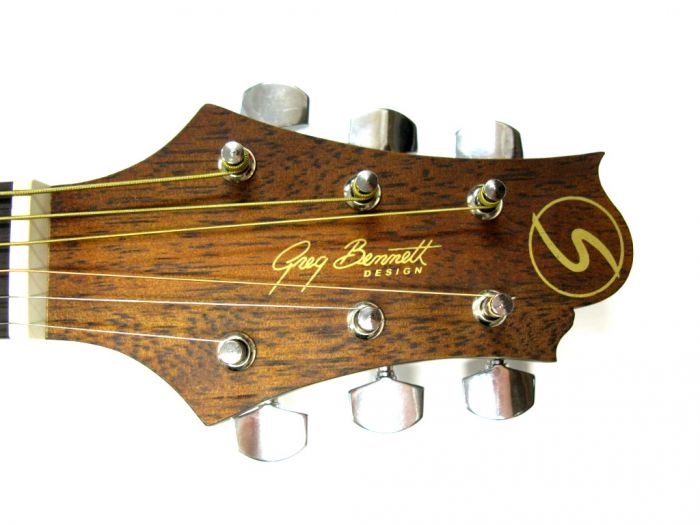
Those have a pretty vocal following online; I saw many reviews (like THIS ONE) saying they’re unbelievable guitars at their price point
Since they’ve won multiple awards over the years, I’m not surprised! They look much like my AMCT, but the headstock is different and says “Greg Bennett” on it.
These days Greg still makes his acoustic line of guitars through Samick, so you can get those new (on THIS WEBSITE) but not the electrics or hybrids, like mine.
And Samick? Oh, they’re still making a TON of guitars every year, and keeping the prices reasonable because of their sheer size and how they’ve streamlined things over the decades. Check their MANY new guitar options on the SAMICK WEBSITE HERE.
I even found one on there that veeeeery much has me G.A.S.-ing… Check out this new TVJZ-50CE:
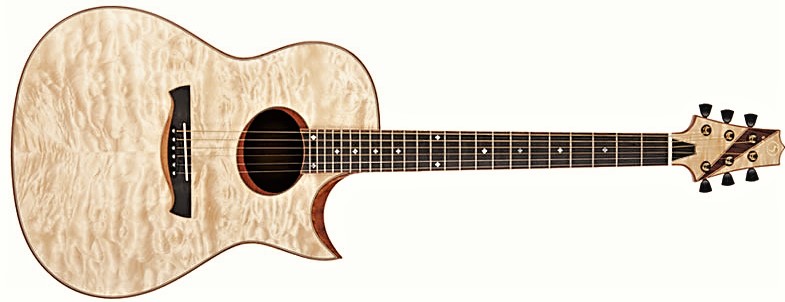
The Syndrome never ends… LoL
Ride That Thin Line!
Now, obviously, this Samick acoustic guitar is long gone from store shelves; you can’t buy one today.
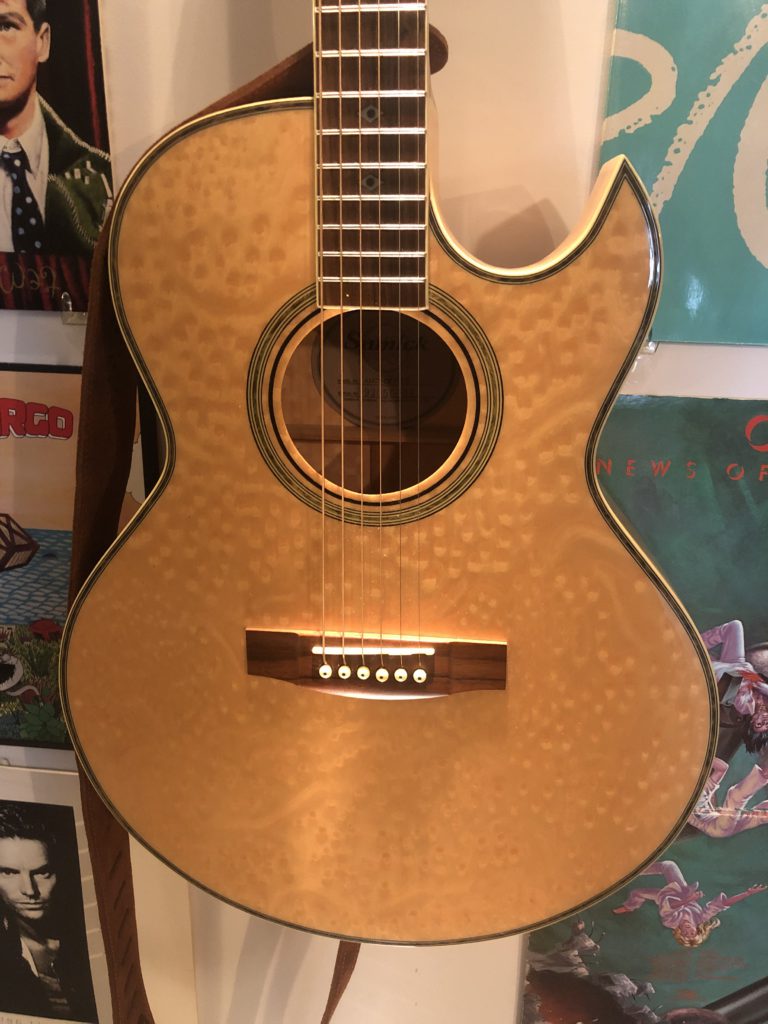
Unless, of course, you keep your eyes open for one online. Set up an eBay “reminder Search” and see what happens.
I looked for something similar to recommned to you but I could not find a single, thin-line acoustic/electric with XLR & 1/4″ outputs anywhere. I’ll keep looking and update here if I find one, but if YOU come across something similar… please let us know!
‘Til then, rock this quarantine with your BEST music, and , go… make… sounds!!
Teaj
I love it when folks get together and share opinions. Great site, continue the good work!
I sold my guitar (this model) in 2008 or 2009 for Christmas money for my kids and I super duper regret it….